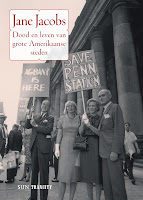A great influential book about (social) urbanism and city planning with a critique on the modernist planning of the early 20th century. Jacobs considers about the city’s community life and describes development seen from a bottom-up methodology, alarming against the arrogance of state power's developers like Robert Moses. The entire book is written within her own experiences by walking around the city’s streets and parks, observing community life.
Most significant are Jacobs’ four principles of diversity, against the great blight of dulness.
Mixed uses of primary user facilities, Short building blocks, buildings of various ages, concentration
A good combination of these principles can, together with a good buildingsrank, lead to diverse neighborhoods and lively community life.
Lack for concentrated diversity gets people in their cars with high needs for highroads and parking lots. This is why Urban Sprawl leads to more concrete, more cars, a while the city center brings vitality, lively urban society, a meeting place for lots of people.
The consequences of Jane Jacob’s battle against top-down city planning continues to this day. The movie “Battle for Brooklyn” is an intimate look at the very public and passionate fight waged by residents and business owners of Brooklyn's historic Prospect Heights neighborhood facing condemnation of their property to make way for the polarizing Atlantic Yards project, a massive plan to build 16 skyscrapers and a basketball arena for the New Jersey Nets, designed by Daniel Libeskind.


No comments:
Post a Comment